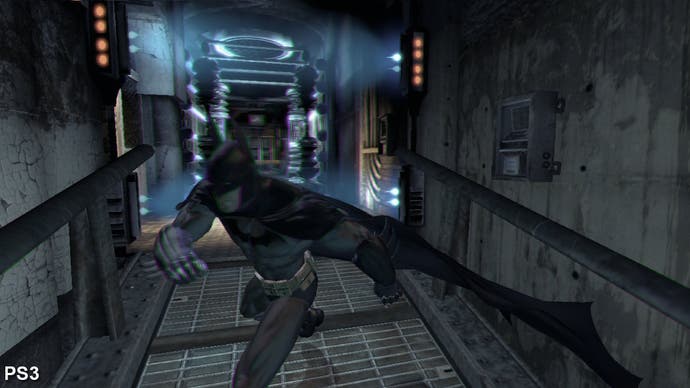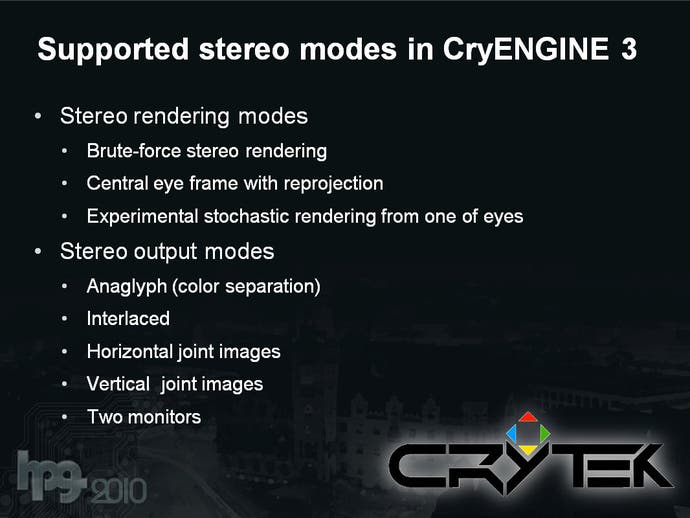PlayStation 3D: Performance Analysis
E3 Killzone demo and 3D launch titles put through their paces.
Performance improvements are something to which Sony is paying a lot of attention. The aim is to make the process of adding 3D less onerous to developers generally. In our previous Making of PlayStation 3D article we described Sony's tentative work in using a 2D image for one eye, then using a technique involving extrapolation of the depth buffer to create the secondary image, with re-projection used to fill gaps in the image and restore the full stereoscopic effect you'd otherwise be missing.
"You'll see a title in the next 12 months using that," SCEE's senior group director Mick Hocking told us during an E3 update on this new technique for generating 3D imagery on the PS3. "The technology's working. It's early days, it's in the prototype stage still so we've still got to put it into a full title and work out all the nuances.
"We have it working on WipEout and it works very nicely but that's only one game type so we'll need to try it with others. It just helps the optimisation although I think... It's just going to lower the bar of entry, perhaps the teams that aren't quite so technically savvy will benefit from that technology."


Others area coming up with their own forms of re-projection that essentially look to offer 3D on the cheap. Digital Foundry has already looked at one of these in-depth in the form of TrioViz, featured in the Game of the Year edition of Batman: Arkham Asylum. TrioViz uses the depth buffer used in generating each frame in concert with the camera position to extrapolate out images for each eye. The current rendition, using paper glasses, is somewhat hit and miss but the performance impact is nowhere near the level required by true stereoscopy.
Hamstrung by the colour filtering on the glasses, TrioViz isn't especially comfortable to use in gameplay. However, the depth effect is there, they have a proven integration path into existing games and the firm now has the tech working with 3DTVs. We suspect that TrioViz will be more than a mere flash in the pan, especially as 3D displays become more commonplace.
Also making an impact at E3 was Crysis 2, which EA displayed running on Xbox 360 (indeed all PR events for console Crysis 2 we're aware of have shown the 360 build thus far). CryTek's potentially massive shooter offers 3D on all three platforms, with the console versions' performance said to be barely impacted by the move to stereoscopic 3D.
"Whenever we show 3D, we show it intentionally on 360 to make the point. It works. It works flawless on PS3, 360 and PC as well. It just works; and one-and-a-half per cent impact only. Out of 30 frames it's 0.4 frames," CryTek CEO Cevat Yerli told VideoGamer.
"I use the term 'for free', with this game. It's so negligible. And people ask, how do you do it? I say, well, we do render only once. That isn't magic. But we create a second image out of the first one. But how we do it is the magic. That's the secret sauce. I'm happy that we figured it out!"


While Cevat Yerli wasn't keen on talking about the tech in any more detail at E3, thankfully he and colleague Anton Kaplanyan were rather more forthcoming at the recent HPG10 event: and their fascinating Powerpoint presentation on the future of game graphics includes a small section on stereo 3D that helps fills in the gaps. Similar to TrioViz, the scene is rendered just once with the depth information used to separate out images for the left and right eye.
We're in the process of chasing down CryTek for an interview, but it will certainly be interesting to see how Crysis 2 fares with the TrioViz "gotchas": transparent effects just seem to hang in mid-air and have no real stereoscopic effect at all. Similarly, this 2D+depth approach typically has other limitations, namely "gaps" in the image that interpolation from a single view can't possibly process (Sony's re-projection approach includes extra processing to correct the second view, ensuring true stereoscopy). Quite how, or if, CryTek has managed to overcome this in a first-person game - where those gaps are likely to be quite obvious - is something we're very curious about.
While PS3 is taking the lead in stereo 3D, the emergence of multi-platform titles with stereoscopy, such as Crysis 2, suggests that if and when the new display standard takes off, PC and 360 won't be so far behind. NVIDIA is planning a "3DTV Play" expansion for its 3D Vision system, allowing you to play their titles on your new screen and the sheer horsepower available suggests that 720p per eye at 60FPS shouldn't be too taxing for much of its GPU line-up.
But is Xbox 360 really 3D ready, to the same standard as the other platforms? That's something Digital Foundry will be covering in more depth in a later feature.








